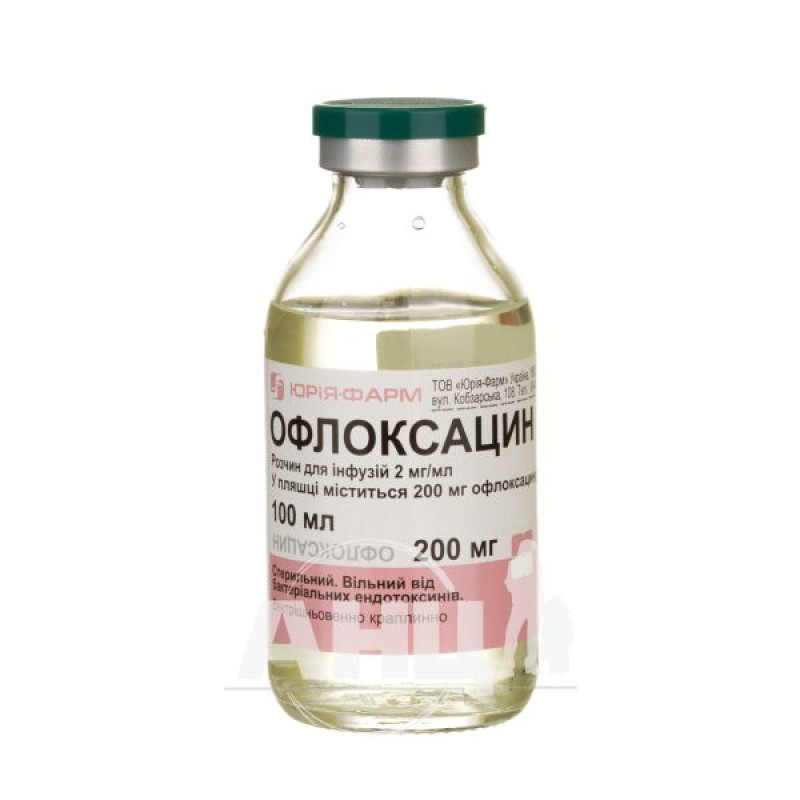Ofloxacin solution for infusion 2 mg/ml bottle 100 ml

Pharmacological properties
Ofloxacin 9-fluoro-2,3-dihydro-3-methyl-10-(4-methyl-1-piperazinyl)-z-7-n-pyrido-{1,2,3 de-1,4-benzoxazinecarboxylic acid) is an antimicrobial agent of the fluoroquinolone group. It has a broad spectrum of antibacterial activity, including strains resistant to many antibiotics and sulfonamides. highly active mainly against aerobic gram-negative bacteria, shows activity against some gram-positive and intracellular microorganisms: escherichia coli, salmonella spp., shigella spp., klebsiella spp., proteus spp., pseudomonas spp., enterobacter spp., serratia spp., citrobacter spp., hafnia spp., yersinia spp., staphylococcus spp., streptococcus spp., neisseria spp., haemophilus influenzae, brucella spp., vibrio spp., providencia spp., chlamidia spp., campylobacter spp., aeromonas spp., plesiomonas spp. acts on bacteria that produce β-lactamases. has a bactericidal effect. treponema pallidum is not sensitive to ofloxacin. the mechanism of bactericidal action of ofloxacin is due to the suppression of bacterial DNA gyrase, which causes their death. ofloxacin also damages the membranes of bacterial cells, which leads to the release of cellular contents. There is no cross-resistance with antibiotics and other antibacterial drugs, except for fluoroquinolones.
Ofloxacin penetrates well into organs and tissues, creates high concentrations in saliva, sputum, bronchial fluid, lungs, bile, gallbladder, prostate gland, urine, skin, bones. The maximum concentration of ofloxacin in blood plasma (after intravenous administration at a dose of 200 mg for 30 minutes) is achieved almost immediately. The half-life of the drug is 5-7 hours. The drug is practically not metabolized; 75-90% is excreted in the urine, and even after a single administration, the drug is in the urine for 20-24 hours.
Indication
Infections caused by microorganisms sensitive to the drug: infections of the respiratory tract, ear, throat, skin, soft tissues, abdominal organs, kidneys, urinary tract; gynecological infections, osteomyelitis, for preoperative prophylaxis and postoperative treatment of surgical infections. Ofloxacin is also used for the prevention and treatment of infections in patients with immunodeficiency states.
Application
Adults are administered intravenously, depending on the severity of the infection, from 200 to 400 mg 2 times a day. The average duration of treatment is 7-10 days. In case of impaired renal function, ofloxacin is initially administered at a dose of 200 mg, then - taking into account creatinine clearance (with creatinine clearance of 20-50 ml/min - 100 mg every 24 hours, with creatinine clearance of 20 ml/min - 100 mg every 48 hours).
Contraindication
Hypersensitivity to quinolones, pregnancy and breastfeeding, age up to 18 years. The drug is prescribed with caution to patients with epilepsy, diseases of the central nervous system with a reduced seizure threshold.
Side effects
Nausea, vomiting, diarrhea, headache, feeling of anxiety, general malaise, sleep disturbances, vision, taste disturbances, allergic reactions (skin rash, itching); possible development of facial edema, vocal cords; changes in blood composition (leukopenia, agranulocytosis, thrombocytopenia), hyperbilirubinemia, myalgia, arthralgia.
Special instructions
It is prescribed with caution to patients with severe atherosclerosis of cerebral vessels, impaired cerebral circulation, impaired renal function. When using ofloxacin, one should refrain from performing work that requires a quick reaction. Slowing down the reaction rate is complicated by alcohol consumption. In case of side effects, especially from the nervous system, or allergic reactions that may occur after the first administration, the drug must be immediately canceled. During treatment with ofloxacin, ultraviolet radiation is contraindicated.
Interactions
Ofloxacin should not be administered simultaneously with antacids or iron preparations to avoid reduced efficacy. Ofloxacin, unlike other fluoroquinolone drugs, does not increase theophylline plasma levels when administered simultaneously.
Overdose
Manifested by nausea, vomiting, tachycardia, headache, psychomotor agitation; in case of overdose, drug withdrawal, adequate hydration, ECG monitoring, and symptomatic therapy are indicated.
Storage conditions
In a place protected from light at a temperature of 10-25 °C.
There are no reviews for this product.
There are no reviews for this product, be the first to leave your review.
No questions about this product, be the first and ask your question.




